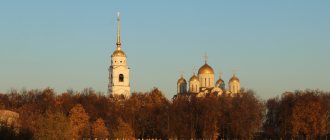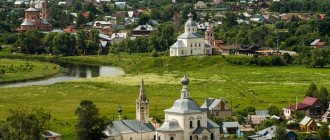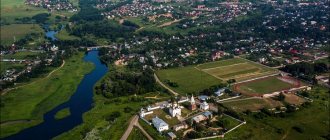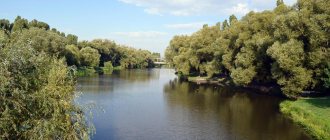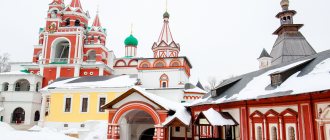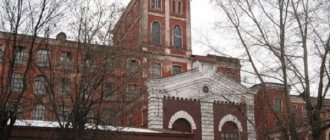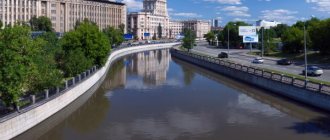Petushki: areas, recreation, excursions, museums and churches, cuisine and restaurants, shopping and shops, attractions of Petushki.
- New Year tours
to Russia - Last minute tours
to Russia
A small provincial town, a regional center, an inconspicuous point on the map of Russian tourism - this can be said about most cities in Russia, but not about Petushki. Every third compatriot who has heard the phrase “Moscow - Petushki” knows about the city with a population of only 15 thousand people. This is the title of a poem by Venedikt Erofeev, who only lived and worked in Petushki for a couple of years, but with his poem brought it into the country’s literary heritage.
A small provincial town, a regional center, an inconspicuous point on the map of Russian tourism - this can be said about most cities in Russia, but not about Petushki.
How to get to Petushki
Petushki is a city in the Vladimir region, connecting the once ancient capital of Rus' Vladimir with the modern capital. Just 120 km east of Moscow along the M7 highway, and you are in a quiet town, where there is room for both sightseeing and outdoor recreation. {{Slimness wallet| You can get here by train from the Kursky station (ticket price - from 376 RUB), or from the platforms of the Gorky direction, for example, from the Serp and Molot station near the Rimskaya metro station. Prices on the page are indicated for February 2021. By car, time in The journey will be only an hour; if there are no traffic jams, the train ride will take a little more than two hours.
Sights of Petushki
- New user?
- Already registered with us?
The oldest online publication for business travelers, providing information necessary for planning business trips, vacations, all kinds of trips and trips. The site provides information on sections: cities and countries, regions, villages and towns, embassies, air and railway schedules, taxis, hotels, boarding houses, hostels, mini-hotels, restaurants, cafes, clubs, saunas, theaters, museums and much much more. More details
- News
- Reviews about us
- Photo gallery
- Souvenirs
- People
- Forms
02/07/2020 For the 20th anniversary of the project, we have started updating the site! Already some pages of the mobile version look new! Read more
- About the site
- Write to us
- Found a mistake?
- Add object
Introducing a service for sending requests for group accommodation to find the best price. Your application will be sent to all hotels that match your request. You will learn about the availability, prices and service of all hotels by sending only one application.
To start working, authorization is required. Before sending, each application is checked by the site administrator.
Applications are sent during the working hours of hotel reservation departments.
Introducing a service for sending requests for group accommodation to find the best price. Your application will be sent to all hotels that match your request. You will learn about the availability, prices and service of all hotels by sending only one application.
To start working, authorization is required. Before sending, each application is checked by the site administrator.
Applications are sent during the working hours of hotel reservation departments.
Submit your request and we will find hotels that can fulfill it. In response, the hotels will send you offers and you can choose the most attractive one.
- To continue, you must register or log in →
You can try changing the request parameters.
Based on your request, we found [Loading map. ], we recommend limiting your search area.
Fill out the remaining information to send your application to all found hotels at once. In response, they will send you offers by email or contact you by phone.
ATTENTION! If you do not receive an application confirmation email within 5 minutes, please check your SPAM box. If there is no email from us, it means you have entered an incorrect email address.
A little history
The first mention of a settlement with the unusual name Petushki dates back to the 17th century, in the 19th century. The village of Petushki grew from the village of Starye Petushki. It became a city only in 1965. Tourists are usually of keen interest in the origin of such an unusual name. There are several versions to explain it: the popularity of cockerels-whistles in these places; the custom of placing a rooster's head in a corner when building a house; widespread use of the image of a rooster to decorate the lid over the chimney (smoke chamber); imitation of a cock's crow during raids on rich carriages - in the Vladimir region, according to folklore legends, this is how the gang of the robber Kudeyar operated.
Entertainment and attractions
As in all regional centers, the city has an Art Gallery and a Museum of Local Lore. But this is not symbolic. A representative attraction of Petushki is the Rooster Museum. Here you can see a whole set of different types of roosters, made in completely different genres. A racing rooster painted in Khokhloma, a rebel rooster made in Gzhel, a crystal brawler rooster or a clay bully rooster. You should definitely come here to learn about decorative and applied arts.
The “rooster theme” is not finished yet, but requires improvement. So, at the entrance to the city from the west there is a pedestal with the inscription “Petushki”, standing and waiting for it to be repaired or at least “washed”.
Another landmark of the city is the water tower of a smooth hyperboloid shape. This creation of the design of Academician V. G. Shukhov is very similar to the Moscow Tower on Shabolovka Street.
In Russia, there are only 8 such towers left out of 200 built throughout the country. It is believed that such buildings and the architecture of the famous Spanish architect Antonio Gaudi have something in common, for example, smoothness and streamlined forms. You can appreciate all this with your own eyes - fortunately, in Petushki the objects are within walking distance of each other.
And, of course, not a single Russian city can do without a church. There are two churches in Petushki, built almost 100 years apart. 1910 is the year of the consecration of the Holy Assumption Cathedral. 2002 is the year of the opening of the temple in the name of St. Athanasius. 5 km from the city in the village of Leonovo there is another Epiphany Church built in 1820. Pilgrims should visit the local holy places. It is incredibly quiet and peaceful around them.
Small towns of Russia: Petushki
Cockerels
The city of Petushki is the administrative center of the Petushinsky district of the Vladimir region, one of the smallest cities - with a population of 13,382 people (2017). Petushki is located on the left bank of the Klyazma River, 63 km southwest of Vladimir. The Moscow-Nizhny Novgorod railway and the M-7 Volga highway pass through the city.
Story
Petushki is a provincial town that was a village half a century ago. It arose at the Petushki station, opened in 1861. The station was named after the neighboring village of Petushki (today it is Starye Petushki). This village was first mentioned in church census books in 1678. Residents of Petushki have long been engaged in “janitoring”, that is, maintaining inns, which was determined by the location of the village - on the high road running from Moscow to Vladimir, and then to Nizhny Novgorod.
Since the 18th century The Vladimirsky tract (the notorious Vladimirka) was used to send convicts to Siberia for hard labor. The prisoners, shackled, were “led along the stage” on foot in small detachments-parties. After walking 15–25 versts (stage), the prisoners stopped for a rest. The tragic history of the road inspired the artist I.I. Levitan to create the painting “Vladimirka” when he was on vacation in these places in 1891 (now the museum “House of Landscape named after I.I. Levitan” has been opened in the village of Eliseikovo, Petushinsky district).
The railway under construction determined the transition of part of the residents of the village of Petushki closer to it and the formation of a settlement with a wooden railway station. By 1869, when double-track train service appeared, a large brick station (still preserved) and a locomotive depot were built at the station. The station became the administrative station, where locomotives were changed, inspected and repaired, and work on the loading and dispatch of timber and firewood was expanded. Along with the station, the settlement grew, turning into the station workers' village of Petushki.
There are many interpretations of the name of the settlement - Petushki. The most peaceful of them are associated either with the traditional production in these places of children's whistles in the shape of cockerels, which were in great demand at the Nizhny Novgorod and Makaryevskaya fairs, or with the rooster-shaped chimneys common here, which are still preserved on some houses. But there are also quite sinister interpretations: robbers, who have long traded on the high road, attacking passing merchants, warned of their appearance by the crowing of a rooster. And also, supposedly, there was a custom, apparently for good luck, of placing the severed head of a rooster on the corner of the foundation when laying a house. Whatever the version, cockerels - the symbol of the city - are today depicted on the official coat of arms, approved in 2009.
The construction of the railway attracted entrepreneurs, and in the 1910s, industrial production began to emerge in Petushki: the Krasheninnikov brothers built a weaving factory for 50 handlooms (later - the Trudovoy Collective factory); entrepreneur Dyukov opened a pleat-cutting artel producing velvet; the turning and carpentry factory of Drozhzhin and Efremov was founded, which later became a bobbin-and-reel factory; The Genushkevich plant began producing sand-lime bricks.
The village of Petushki received the status of a village in 1910, when a magnificent temple built here at the expense of the local manufacturer Kuznetsov - the Holy Assumption Church, which is still in use today - was consecrated.
The station village developed, attracting the surrounding population, and expanded with new streets. In 1928, it received the status of an urban-type workers' settlement and was renamed Novye Petushki. In 1929, it became the center of the first formed Petushinsky district. Petushki became a city only in 1965.
Economy
Today Petushki, although a small town, is still an industrial center with a number of enterprises, including such a unique and promising plant as a steel piston ring plant. Still, the main range of production is light industry, mainly textile and food industries.
Attractions
Of tourist interest may be one of the eight hyperboloid towers preserved in Russia, designed by the engineer and scientist V.G. Shukhov (the most famous Shukhov tower on Shabolovka in Moscow). He was the first in the world to create such a steel mesh structure for the All-Russian Exhibition in Nizhny Novgorod in 1896. However, the condition of the Petushin water tower today is quite deplorable.
The city has the only Rooster Art Museum in Russia, founded in 1997 by artist and journalist N. Kornilov. The museum contains a large collection of paintings, dishes, embroidery, and installations made from various materials on a “rooster” theme, which is of great interest to both children and adults. The museum is located in the district House of Culture.
Famous people
The city entered the Russian cultural context after the appearance of V. Erofeev’s poem “Moscow - Cockerels” (1970, officially published in the USSR only in 1988). Venichka Erofeev himself lived in Petushki for no more than two years. He first came here in 1959 and got a job as a loader at a cement warehouse. Contrary to popular belief, there is no monument to Venedikt Erofeev in Petushki. In 2000, a monument to Erofeev was erected in Moscow, in a public garden on Borby Square (Mendeleevskaya metro station). A small museum of the writer has been created in Petushki (Sovetskaya Square, 3), the exhibition of which presents the writer’s personal belongings, literally collected bit by bit from all over Russia.
Author: V. Korolkova
Leisure
We advise residents of large cities to go to Petushki to relax in the fresh air. There are all possibilities for this.
For a wild holiday, you can pitch a tent near a pond.
Fortunately, there are enough of them here: the Klyazma and Berezka rivers, lakes Gribovskoye, Chupriyanovo, Bogdarinskoye, Ignatkovo and several quarries. The Moscow public prefers to go to Petushki on weekends to relax at tourist centers and boarding houses, so it is better to book them in advance in the summer and during the holidays. There is excellent fishing and rich berry and mushroom spots.
Erofeev and Petushki
The town was introduced into the cultural life of Russia by the writer Venedikt Erofeev. According to one version, one of the local residents, Valentina Zimanova, became the prototype of the heroine of his poem “Moscow-Petushki”, which the lyrical hero so strove for. The author, who arrived here in 1959, spent no more than two years in the town.
In the nineties, information appeared that a monument to Venichka had been erected at the city station. Thanks to this rumor, guests of the city who are familiar with the poem unsuccessfully search for the monument.
The monument actually exists, but only in a different place. The initial project assumed that the first part of the complex, Venichka, would be installed at the Kursk station of the capital. His Beloved should have been staged in Petushki.
The entire monument was moved in 2000 to the Mendelevskaya metro station, to a small public garden. A quote from the work is carved on the pedestal of the statue of the beloved hero. But in Petushki there is a museum of the writer.

